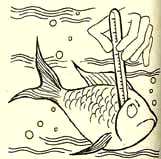Fishing out temperature
 SCIENTISTS from the University of Michigan in the US have discovered that stony lumps of calcium carbonate, known as otoliths, found in the ears of most fishes, can offer clues to seasonal temperatures thousands or even millions of years ago (Science, Vol 258 No 5085).
SCIENTISTS from the University of Michigan in the US have discovered that stony lumps of calcium carbonate, known as otoliths, found in the ears of most fishes, can offer clues to seasonal temperatures thousands or even millions of years ago (Science, Vol 258 No 5085).
The finding has given a new turn to the old method of tracking ancient climate by analysing oxygen isotopes in tiny fossils from seafloor sediments. Geologists William Patterson and K C Lohman and paleontologist Gerald Smith conjectured otoliths from freshwater fishes might give them a record of seasonal temperature extremes on land. Every day a fish adds a whisper-thin layer of carbonate to the otoliths in its ears. By slicing open the ancient otoliths found in fossil deposits, counting these daily growth rings and by analysing the oxygen isotopes at closely spaced intervals, researchers hope to trace shifts in water temperature over a short period.
Analysing otoliths from modern fish to see how isotopes vary with changes in water temperature and composition, researchers have already found isotope fluctuation in otoliths that are 3.5 million years old and may soon be able to provide a glimpse of a typical year for a dinosaur.
Related Content
- Identifying climate adaptive solutions to displacement in Somalia: assessment report
- Impacts of climate change on fisheries and aquaculture: synthesis of current knowledge, adaptation and mitigation options
- Addressing climate induced loss and damages: perception and thoughts of the coastal fishers in Bangladesh
- High Risk That Temperatures Could Exceed Thermal Survival Limits For Many Fish Species By 2070, Study Finds
- Climate Change Could Cause Fish to Shrink in Size
- Climate change could shrink fish size by 30 per cent: Study
